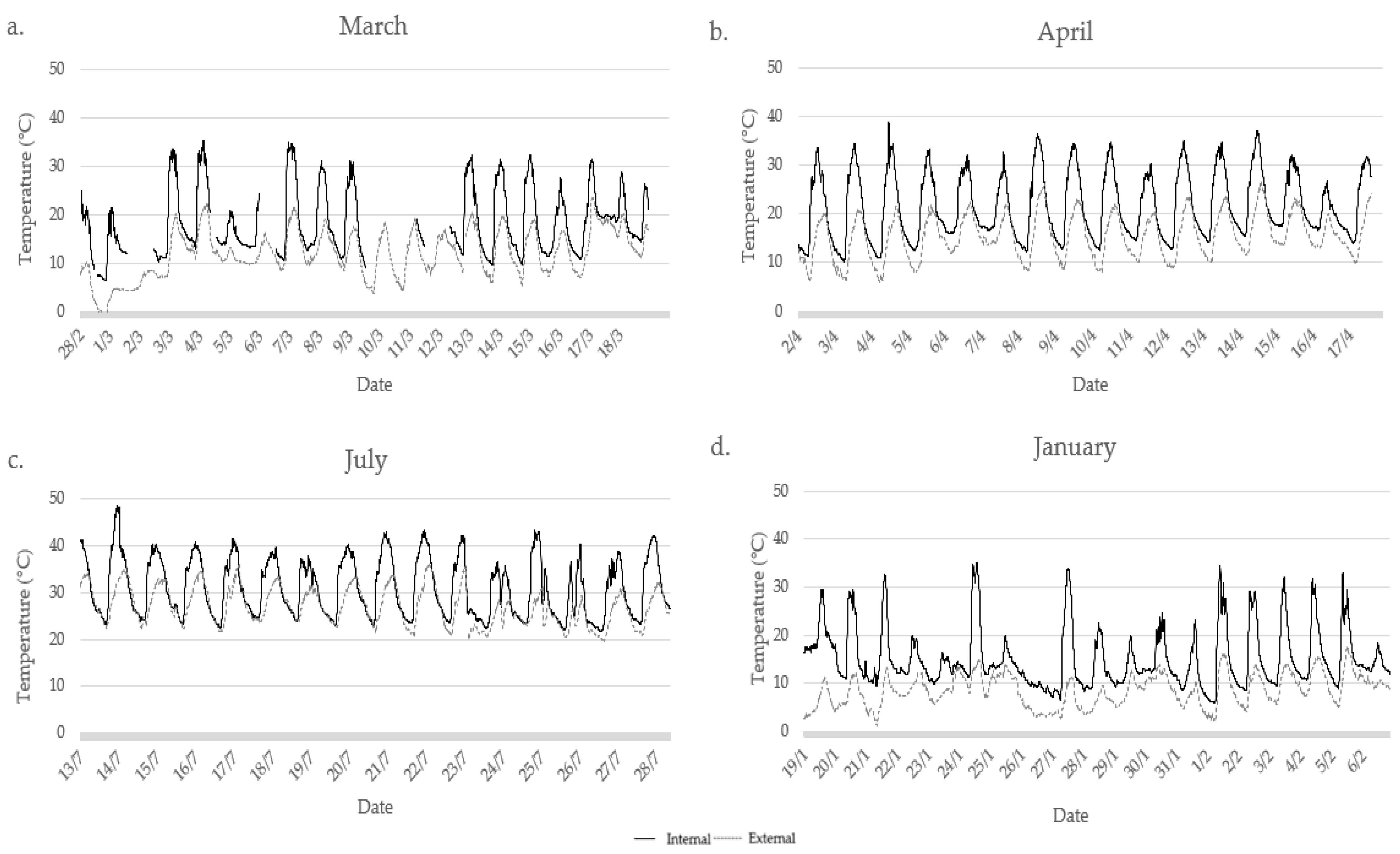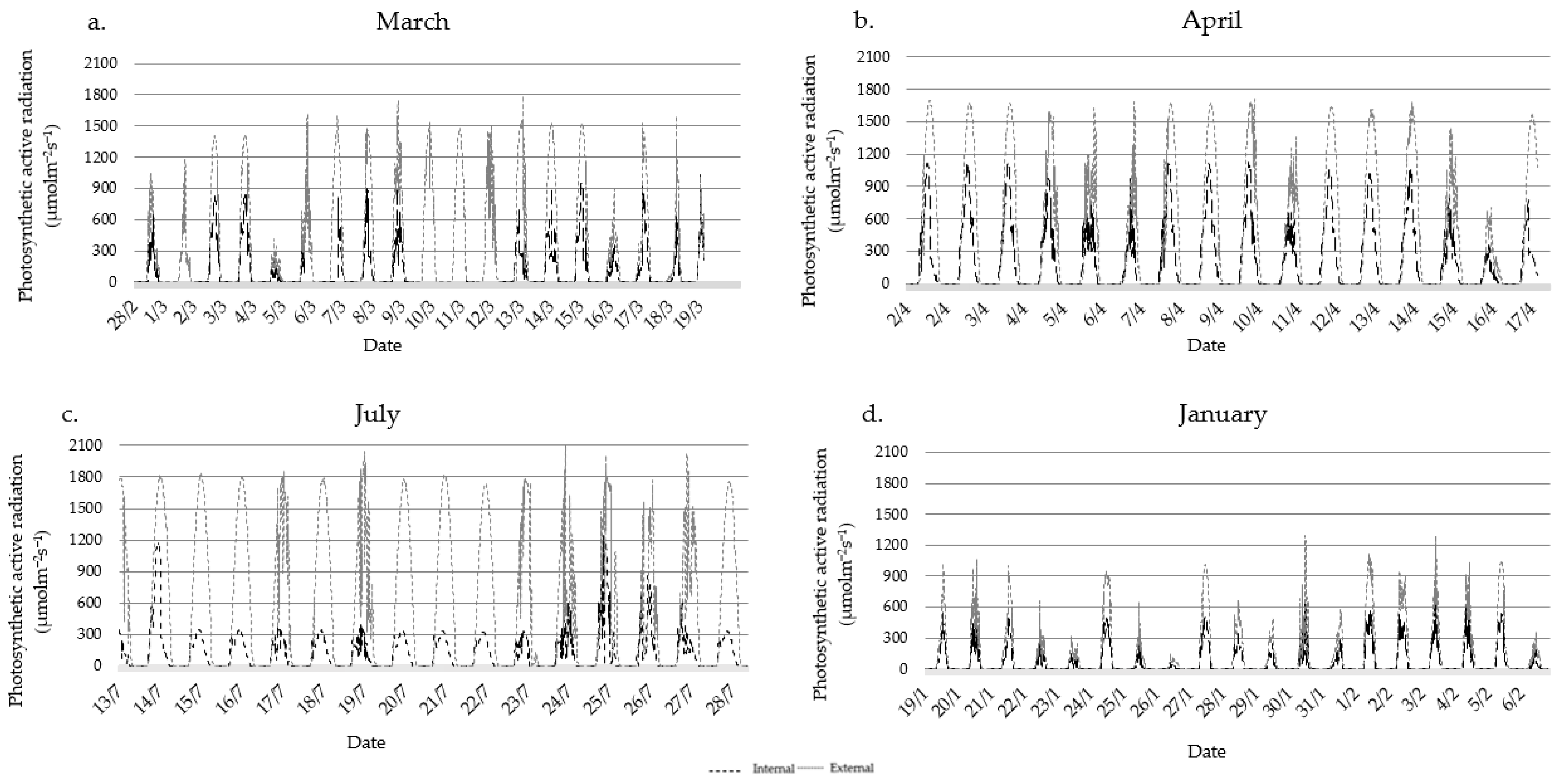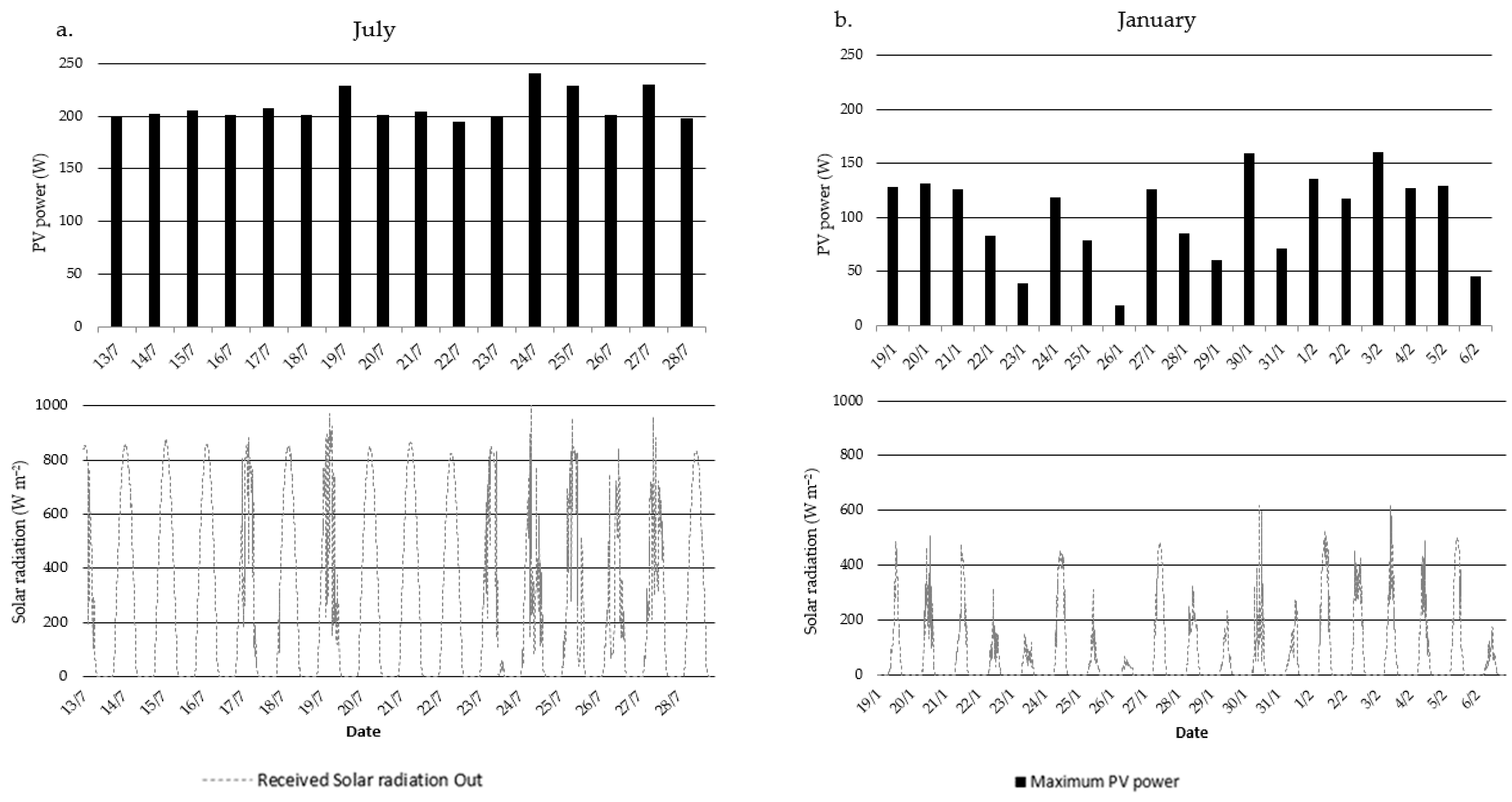Energy Use Efficiency and Carbon Footprint of Greenhouse Hydroponic Cultivation Using Public Grid and PVs as Energy Providers
Abstract
:1. Introduction
2. Materials and Methods
2.1. Experimental Set Up and Microclimate Measurements
2.2. Energy Analysis and Energy Use Efficiency
2.3. Carbon Footprint of the Energy Consumption
2.4. Statistical Analysis
3. Results and Discussion
3.1. Greenhouse Microclimate Conditions
3.1.1. Air Temperature and Relative Humidity (RH)
3.1.2. Photosynthetic Active Radiation (PAR) Evaluation
3.2. Root Zone Temperature per Tank
3.3. Energy Analysis, Energy Use Efficiency (EUE) and Total Yield per Experimental Period
3.4. Carbon Footprint Calculation and Year-Round Cultivation Case Study
4. Conclusions
Author Contributions
Funding
Institutional Review Board Statement
Informed Consent Statement
Data Availability Statement
Conflicts of Interest
References
- Panwar, N.L.; Kaushik, S.C.; Kothari, S. Solar Greenhouse an Option for Renewable and Sustainable Farming. Renew. Sustain. Energy Rev. 2011, 15, 3934–3945. [Google Scholar] [CrossRef]
- Gruda, N.; Bisbis, M.; Tanny, J. Influence of Climate Change on Protected Cultivation: Impacts and Sustainable Adaptation Strategies—A Review. J. Clean. Prod. 2019, 225, 481–495. [Google Scholar] [CrossRef]
- Khan, F.A. A Review an Hydroponic Greenhouse Cultivation for Sustainable Agriculture. Int. J. Agric. Environ. Food Sci. 2018, 2, 59–66. [Google Scholar] [CrossRef] [Green Version]
- Djevic, M.; Dimitrijevic, A. Energy Consumption for Different Greenhouse Constructions. Energy 2009, 34, 1325–1331. [Google Scholar] [CrossRef]
- Gruda, N. Impact of Environmental Factors on Product Quality of Greenhouse Vegetables for Fresh Consumption. CRC Crit. Rev. Plant Sci. 2005, 24, 227–247. [Google Scholar] [CrossRef]
- Gruda, N.; Bisbis, M.; Tanny, J. Impacts of Protected Vegetable Cultivation on Climate Change and Adaptation Strategies for Cleaner Production—A Review. J. Clean. Prod. 2019, 225, 324–339. [Google Scholar] [CrossRef]
- Yildirim, N.; Bilir, L. Evaluation of a Hybrid System for a Nearly Zero Energy Greenhouse. Energy Convers. Manag. 2017, 148, 1278–1290. [Google Scholar] [CrossRef]
- Campiotti, A.C.; Bibbiani, C.; Dondi, F.; Viola, C. Efficienza energetica e fonti rinnovabili per l’agricoltura protetta. Ambiente Risorse Salut. 2010, 126, 6–12. [Google Scholar]
- Sagheer, A.; Mohammed, M.; Riad, K.; Alhajhoj, M. A Cloud-Based IoT Platform for Precision Control of Soilless Greenhouse Cultivation. Sensors 2020, 21, 223. [Google Scholar] [CrossRef]
- FAO. Unlocking the Potential of Protected Agriculture in the Countries of the Gulf Cooperation Council—Saving Water and Improving Nutrition; FAO: Cairo, Egypt, 2021. [Google Scholar]
- Terrosi, C.; Cacini, S.; Burchi, G.; Cutini, M.; Brambilla, M.; Bisaglia, C.; Massa, D.; Fedrizzi, M. Evaluation of Compressor Heat Pump for Root Zone Heating as an Alternative Heating Source for Leafy Vegetable Cultivation. Energies 2020, 13, 745. [Google Scholar] [CrossRef] [Green Version]
- Ntinas, G.K.; Neumair, M.; Tsadilas, C.D.; Meyer, J. Carbon Footprint and Cumulative Energy Demand of Greenhouse and Open-Field Tomato Cultivation Systems under Southern and Central European Climatic Conditions. J. Clean. Prod. 2017, 142, 3617–3626. [Google Scholar] [CrossRef]
- Ntinas, G.K.; Kadoglidou, K.; Tsivelika, N.; Krommydas, K.; Kalivas, A.; Ralli, P.; Irakli, M. Performance and Hydroponic Tomato Crop Quality Characteristics in a Novel Greenhouse Using Dye-Sensitized Solar Cell Technology for Covering Material. Horticulturae 2019, 5, 42. [Google Scholar] [CrossRef] [Green Version]
- Ntinas, G.K.; Dannehl, D.; Schuch, I.; Rocksch, T.; Schmidt, U. Sustainable Greenhouse Production with Minimised Carbon Footprint by Energy Export. Biosyst. Eng. 2020, 189, 164–178. [Google Scholar] [CrossRef]
- ISO 14044; International Standard. Environmental Management—Life Cycle Assessment—Requirements and Guidelines. International Organization for Standardization: Geneva, Switzerland, 2006.
- Boulard, T.; Raeppel, C.; Brun, R.; Lecompte, F.; Hayer, F.; Carmassi, G.; Gaillard, G. Environmental Impact of Greenhouse Tomato Production in France. Agron. Sustain. Dev. 2011, 31, 757–777. [Google Scholar] [CrossRef] [Green Version]
- Pérez Neira, D.; Soler Montiel, M.; Delgado Cabeza, M.; Reigada, A. Energy Use and Carbon Footprint of the Tomato Production in Heated Multi-Tunnel Greenhouses in Almeria within an Exporting Agri-Food System Context. Sci. Total Environ. 2018, 628–629, 1627–1636. [Google Scholar] [CrossRef]
- Almeida, J.; Achten, W.M.J.; Verbist, B.; Heuts, R.F.; Schrevens, E.; Muys, B. Carbon and Water Footprints and Energy Use of Greenhouse Tomato Production in Northern Italy. J. Ind. Ecol. 2014, 18, 898–908. [Google Scholar] [CrossRef]
- Lennard, W.A.; Leonard, B.V. A Comparison of Three Different Hydroponic Sub-Systems (Gravel Bed, Floating and Nutrient Film Technique) in an Aquaponic Test System. Aquac. Int. 2006, 14, 539–550. [Google Scholar] [CrossRef]
- Karnoutsos, P.; Karagiovanidis, M.; Bantis, F.; Chatzistathis, T.; Koukounaras, A.; Ntinas, G.K. Controlled Root-zone Temperature Effect on Baby Leaf Vegetables Yield and Quality in a Floating System under Mild and Extreme Weather Conditions. J. Sci. Food Agric. 2021, 101, 3933–3941. [Google Scholar] [CrossRef]
- Hood, T.M.; Mills, H.A. Root-Zone Temperature Affects Nutrient Uptake and Growth of Snapdragon. J. Plant Nutr. 1994, 17, 279–291. [Google Scholar] [CrossRef]
- Al-Rawahy, M.S.; Al-Rawahy, S.A.; Al-Mulla, Y.A.; Nadaf, S.K. Effect of Cooling Root-Zone Temperature on Growth, Yield and Nutrient Uptake in Cucumber Grown in Hydroponic System During Summer Season in Cooled Greenhouse. J. Agric. Sci. 2018, 11, 47. [Google Scholar] [CrossRef]
- Pennisi, G.; Pistillo, A.; Orsini, F.; Cellini, A.; Spinelli, F.; Nicola, S.; Fernandez, J.A.; Crepaldi, A.; Gianquinto, G.; Marcelis, L.F.M. Optimal Light Intensity for Sustainable Water and Energy Use in Indoor Cultivation of Lettuce and Basil under Red and Blue LEDs. Sci. Hortic 2020, 272, 109508. [Google Scholar] [CrossRef]
- Kittas, C.; Karamanis, M.; Katsoulas, N. Air Temperature Regime in a Forced Ventilated Greenhouse with Rose Crop. Energy Build. 2005, 37, 807–812. [Google Scholar] [CrossRef]
- Amelia, A.R.; Irwan, Y.M.; Leow, W.Z.; Irwanto, M.; Safwati, I.; Zhafarina, M. Investigation of the Effect Temperature on Photovoltaic (PV) Panel Output Performance. Int. J. Adv. Sci. Eng. Inf. Technol. 2016, 6, 682–688. [Google Scholar]
- De Pereira, B.J.; Cecílio Filho, A.B.; la Scala, N. Greenhouse Gas Emissions and Carbon Footprint of Cucumber, Tomato and Lettuce Production Using Two Cropping Systems. J. Clean. Prod. 2021, 282, 124517. [Google Scholar] [CrossRef]







| System Parameters | Nomenclature | Values |
|---|---|---|
| Photovoltaic Panel Ecosun—ES-POLY250 | ||
| Rated Power [W] | Pmpp | 250 |
| Max. Power Voltage [V] | Vmpp | 31.32 |
| Short circuit Current [A] | Isc | 8.86 |
| Open circuit voltage [V] | Voc | 37.62 |
| Max. Power Current [V] | Impp | 8.06 |
| Inverter Steca Elektronik—Solarix PI1100 | ||
| DC Input Voltage | V | 24 |
| DC Max Current | A | 120 |
| AC Output Voltage | V, Hz | 230, 50 |
| AC Max Current | A | 13 |
| Charge Controller—Charger OutBack Power—FLEXmax-8 | ||
| Max PV source Voltage (open circuit) | VDC | 150 |
| Max PV Current (short circuit) | AMPS DC | 64 |
| Max Input/Output Current | AMPS DC | 80 |
| Max Battery Charge Voltage | V | 12/24/36/48/60 |
| Range of Operating PV Voltage | VDC | 15–145 |
| Storage System Ecosun—ECOAGM A-220-12 | ||
| Rated Capacity | Ah | 180 |
| Weight | kg | 60.5 |
| Rated Voltage | V | 12 |
| Operating Temperature Range | °C | −20 to +50 |
| Experimental Period | RZT (Min) | RZT (Max) | RZT (Mean) | ||||||
|---|---|---|---|---|---|---|---|---|---|
| PPG | PV | Control | PPG | PV | Control | PPG | PV | Control | |
| March | 21.5 | 21.1 | 15.9 | 23.1 | 23.2 | 18.1 | 22.2 | 22.2 | 17.0 |
| April | 21.6 | 22.1 | 20.6 | 25.8 | 26.3 | 24.9 | 23.7 | 24.2 | 22.7 |
| July | - | 20.6 | 28.6 | - | 23.2 | 30.9 | - | 21.9 | 29.8 |
| January | 21.4 | 14.3 | 10.7 | 22.5 | 18.7 | 13.5 | 22.0 | 16.3 | 12.1 |
| Experimental Period | Heat | Yield (kg m−2) | Energy Consumption | CF (Area FU) (kg CO2-eq m−2) | CF (Mass FU) (kg CO2-eq kg−1) | EUE (kg kWh−1) | |
|---|---|---|---|---|---|---|---|
| (kWh) | (kWh m−2) | ||||||
| First | PPG | 3.8 a | 50.0 | 20.0 | 23.3 | 6.1 | 0.19 |
| 28/2–19/03 | PV | 3.3 a | 35.0 | 14.0 | 1.1 | 0.3 | 0.24 |
| Control | 3.2 a | - | - | - | - | - | |
| Second | PPG | 3.5 b | 26.0 | 10.5 | 12.2 | 3.4 | 0.34 |
| 2/4–17/4 | PV | 3.1 a | 12.0 | 4.8 | 0.4 | 0.1 | 0.51 |
| Control | 4.0 b | - | - | - | - | ||
| Third | PPG | 2.3 * | 87.6 * | 35.0 * | 40.8 | 17.7 | 0.06 |
| 13/7–27/7 | PV | 2.3 a | 73.0 | 29.2 | 2.3 | 1.0 | 0.08 |
| Control | 1.7 b | - | - | - | - | - | |
| Fourth | PPG | 2.6 ab | 125.0 | 50.0 | 58.3 | 22.4 | 0.05 |
| 19/1–6/2 | PV | 2.3 a | 12.0 | 4.8 | 0.4 | 0.2 | 0.48 |
| Control | 2.0 b | - | - | - | - | - | |
| PPG | 12.3 | 288.6 | 115.5 | 134.8 | 49.7 | 0.64 | |
| Total Sum | PV | 11.0 | 135.0 | 52.8 | 4.1 | 1.6 | 1.31 |
| Control | 11.0 | - | - | - | - | - | |
| Season | Heat | Yield (kg m−2) | Energy Consumption | CF (Area FU) (kg CO2-eq m−2) | CF (Mass FU) (kg CO2-eq kg−1) | EUE (kg kWh−1) | |
|---|---|---|---|---|---|---|---|
| (kWh) | (kWh m−2) | ||||||
| Spring | PPG | 20.5 | 211.8 | 84.7 | 98.9 | 4.8 | 0.24 |
| March– May 2018 | PV | 17.7 | 139.3 | 55.7 | 4.4 | 0.2 | 0.32 |
| Control | 20.1 | - | - | - | - | - | |
| Summer | PPG | 14.9 | 575.6 | 230.2 | 268.7 | 18.0 | 0.06 |
| June– August 2018 | PV | 14.9 | 479.7 | 191.8 | 15.0 | 1.0 | 0.08 |
| Control | 11.3 | - | - | - | - | - | |
| Autumn | PPG | 20.3 | 209.5 | 83.8 | 97.8 | 4.8 | 0.24 |
| September– November 2018 | PV | 17.5 | 137.8 | 55.1 | 4.3 | 0.2 | 0.32 |
| Control | 19.9 | - | - | - | - | - | |
| Winter | PPG | 13.9 | 661.7 | 264.7 | 308.9 | 22.2 | 0.05 |
| December 2018–February 2019 | PV | 12.2 | 63.5 | 25.4 | 2.0 | 0.1 | 0.48 |
| Control | 10.5 | - | - | - | - | - | |
| PPG | 69.7 | 1658.6 | 663.4 | 774.2 | 49.9 | 0.59 | |
| Total Sum | PV | 62.5 | 802.3 | 328.0 | 25.7 | 1.6 | 1.2 |
| Control | 62.0 | - | - | - | - | - | |
Disclaimer/Publisher’s Note: The statements, opinions and data contained in all publications are solely those of the individual author(s) and contributor(s) and not of MDPI and/or the editor(s). MDPI and/or the editor(s) disclaim responsibility for any injury to people or property resulting from any ideas, methods, instructions or products referred to in the content. |
© 2023 by the authors. Licensee MDPI, Basel, Switzerland. This article is an open access article distributed under the terms and conditions of the Creative Commons Attribution (CC BY) license (https://creativecommons.org/licenses/by/4.0/).
Share and Cite
Liantas, G.; Chatzigeorgiou, I.; Ravani, M.; Koukounaras, A.; Ntinas, G.K. Energy Use Efficiency and Carbon Footprint of Greenhouse Hydroponic Cultivation Using Public Grid and PVs as Energy Providers. Sustainability 2023, 15, 1024. https://doi.org/10.3390/su15021024
Liantas G, Chatzigeorgiou I, Ravani M, Koukounaras A, Ntinas GK. Energy Use Efficiency and Carbon Footprint of Greenhouse Hydroponic Cultivation Using Public Grid and PVs as Energy Providers. Sustainability. 2023; 15(2):1024. https://doi.org/10.3390/su15021024
Chicago/Turabian StyleLiantas, Georgios, Ioanna Chatzigeorgiou, Maria Ravani, Athanasios Koukounaras, and Georgios K. Ntinas. 2023. "Energy Use Efficiency and Carbon Footprint of Greenhouse Hydroponic Cultivation Using Public Grid and PVs as Energy Providers" Sustainability 15, no. 2: 1024. https://doi.org/10.3390/su15021024








